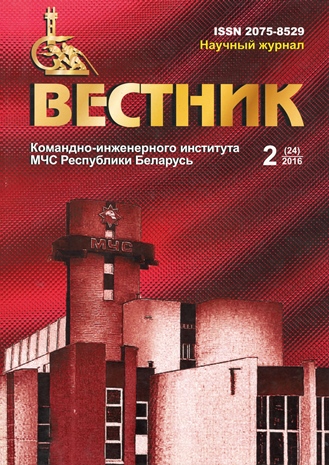Autoclaved aerated concrete fire resistance based on stress-strain diagrams after high heating
Keywords:
fire resistance, autoclaved aerated concrete, stress-strain diagrams, temperature, shrinkageAbstract
Purpose. The paper is devoted to experimental study data of autoclaved aerated concrete stress-strain diagrams after high heating and fire resistance evaluation.
Methods. The specimens of autoclaved aerated concrete were heated in muffle furnace and tested at breaking machine. The results were analytically discussed and fire resistance evaluation technique pro-posed.
Findings. The autoclaved aerated concrete stress-strain diagrams after heating are found. Shrinkage rate depending on temperature is determined. The fire resistance evaluation technique is proposed. Research application field. The obtained experimental study data could be used in fire resistance design of autoclaved aerated concrete structures.
Conclusions. Fire resistance design of autoclaved aerated concrete structures should include stress-strain diagrams after heating study jointed with shrinkage rate.
References
Sazhnev N.P., Tkachik P.P. Aerated concrete in the Republic of Belarus. Production and use experience of aerated autoclaved concrete: proceedings of the 8th International Scientific and Practical Conference. Minsk – Mogilev, 11–13 June 2014. the Editorial .: NP Sazhnev (Ed. Ed.) [Et al.]. Minsk, 2014. P. 5–9. (rus)
Technical Code of Good Practice 45-2.02-110-2008 (02250). Building constructions. Calculation procedures of fire resistance limits. Introduced on 12.06.2008. Minsk: RUE «Stroitechnorm», 2008. 126 p. (rus)
Technical Code of Good Practice EN 1996-1-2-2009 (02250). Eurocode 6. Design of masonry structures. Part 1-2. Structural fire design. Introduced on 01.01.2010. Minsk : Ministry of Architecture, 2010. 100 p. (rus)
Belarus Standard EN 12602-2011. Prefabricated reinforced components of autoclaved aerated concrete. Introduced on 01.07.2012. Minsk : State Standard, 2013. 150 p. (rus)
Galkin, SL The use of aerated concrete products. Theory and practice. / SL Galkin [et al.]. Minsk: Strinko, 2006. 448 p. (rus)
Belarus Standard 1117-98*. Wall blocks of cellular concrete. Specifications. Introduced on 01.04.1999. Minsk State Standard, 2015. 15 p. (rus)
State Standard of the USSR 24452-80. Concretes. Methods for determining the prism strength, elastic modulus and Poisson's ratio. Introduced on 01.01.1982. Moscow : Publishing House of Standards, 1989. 16 p. (rus)
State standard 10180-2012. Concretes. Methods for strength determination using reference specimens. Introduced on 02.01.2016. Minsk : State Standard, 2015. 33 p. (rus)
Polevoda I.I. Fire resistance of reinforced high-strength concrete bending structures. Cand. tehn. sci. diss. : 05.23.01. Minsk: Belarusian National Technical University, 2004. 122 p. (rus)
Kudryashov V.A., Polevoda I.I., Kodeba V.M. Basic stress-strain diagrams transformation for heavy concrete with granite aggregate in a short-term high-temperature impact. Vestnik Komandno-inzhenernogo instituta MChS Respubliki Belarus'. 2008. No. 1 (7). Pp. 21–34. (rus)
Published
How to Cite
License
Copyright (c) 2016 Nguen T.K., Kudryashov V.A.
CC «Attribution-NonCommercial» («Атрибуция — Некоммерческое использование») 4.0









